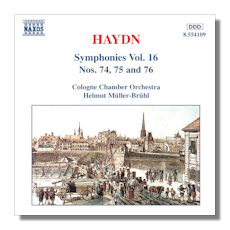
The Internet's Premier Classical Music Source
Related Links
- F.J. Haydn Reviews
- Latest Reviews
- More Reviews
-
By Composer
-
Collections
DVD & Blu-ray
Books
Concert Reviews
Articles/Interviews
Software
Audio
Search Amazon
Recommended Links
Site News
 CD Review
CD Review
Franz Joseph Haydn

Symphonies, Volume 16
- Symphony in E Flat Major, Hob I: 74 (1780)
- Symphony in D Major, Hob I: 75 (1780)
- Symphony in E Flat Major, Hob I: 76 (1782)
Cologne Chamber Orchestra/Helmut Müller-Brühl
Naxos 8.554109 1997 DDD 69:41
What would life be like without the contributions of the great artists and musicians? Franz Joseph Haydn was certainly one of the latter. Listening to his wonderful symphonies offers something akin to a fine dining experience with witty, engaging companionship. Yet, most of the symphonies of this composer are probably passed over by the casual classical music listener who is more impressed by the precocious genius of Mozart or the potent dynamism of Beethoven. However, now that the budget Naxos label has taken to recording the one hundred and four Haydn symphonies with various orchestras and conductors, those casual listeners have less of an excuse to fail to familiarize themselves with these satisfying, enjoyable works. In Haydn's case, quantity did not compromise quality, be it an early symphony (the "day" trilogy of #6,7,8), the late "London" symphonies, or something in-between, such as the symphonies represented by this recording.
Naxos has had quite a way with the master from Rohrau. Their recordings of the Haydn string quartets by the Kodály quartet and various piano works have been consistently on a high level, and I am happy to say that the many symphony releases have faired rather well too despite the variety of recording locales and musicians. The present disc is no exception. In fact, I found it to be attractive not only in price, but in terms of content, performance quality, and recorded sound. At the end of the review I will take a moment and compare the sound quality among various Naxos Haydn symphony recordings.
But first, I can amuse myself by asserting that any particular Haydn symphony might be appropriately characterized as either "stringy" or "windy" according to the primary orchestration employed. In this context, #74 is definitely stringy. The pleasant opening movement is followed by an adagio cantabile that recalls the Romanze feeling of the Mozart E Flat Horn Concerto. The full-toned strings play well throughout the work, and are especially nimble in their articulation of the quick and buoyant finale.
Symphony #75 opens with a bit of an overcast mood, with the clouds lingering on for a full minute and a half. But, in typical Haydn fashion, the skies clear with a single stroke, generated by the brass, strings and tympani. This is a remarkable score, as it displays many contrasts very well. It generates unrestrained nobility in the poco adagio, plus contains a menuetto that could not have been written by anyone else. The vivace finale is bursting with interesting ideas on orchestration, employing shifting keys, varied dynamics, and peek-a-boo themes.
The third work on the disc is the Symphony #76. This piece exhibits robust cheer from the outset. The first movement contains much sophisticated writing and devlopment considering its brief six minute lifespan. Next, the deceptively simple adagio requires over ten minutes, which exceeds the combined length of the two movements that follow. What is interesting about the final allegro is its inevitable "swing" character which showcases Haydn once again as a composer of genius. In it, Haydn dispenses humor embedded in melody and rhythmic invention via sound clusters which start, stop, and restart. The effective use of thematic variation and even repetition demonstrate a composer of extraordinary sensibility and skill.
Each of these delightful works receives a bracing account from an orchestra long renowned for interpretive insights into this composer. The Cologne Kammerorchester supplies everything needed for an enjoyable Haydn experience in modern instrument sound. The conductor, maestro Müller-Brühl, allows the music the space needed to achieve the spontaneity which it deserves. His conceptions are aided by a fine recorded soundstage with good spread and a solid center. Engineer Walter Neuman has captured a pleasing amount of detail and resonance plus quite a hefty bass sound. Recommended.
The other Haydn conductors and orchestras used by Naxos in the past have included Barry Wordsworth with the Capella Istropolitana, Nicholas Ward and the Northern Chamber Orchestra, and Béla Brahos with the Nicolaus Esterházy Sinfonia. There are some differences, to be sure, in the approaches to performance as well as to recorded sound quality. In brief, the 1990 Wordworth effort on Naxos 8.550387 (Syms. 85, 92 and 103) is perhaps a bit "square" and leisurely but wholly reliable nontheless. The sound is full and breathes sweetly with an added measure of hall ambience coming through. Nicholas Ward is a dependable Haydn conductor, though I prefer the old 1963 but excellent stereo effort by Blum and the Esterházy Orchestra especially for Symphony 60, as available on Vanguard. On Naxos 8.550724 (Syms. 22, 29 and 60 - the quirky "Il Distratto"), recorded in 1993, Ward's forces receive close-in, pleasing recorded sound which offers plenty of body and detail, if less bass than the new Müller-Brühl. Finally, I tip my hat especially to Béla Drahos and the Nicolaus Esterházy Sinfonia for Naxos 8.550797 (Syms. 72, 93 and 95) recorded in 1994. This is truly first-rate sound quality, with a wide soundstage, solid center fill, ample detail and a sense of hall space. The spirited performances led by Drahos would make this an outstanding Haydn disc at any price.
Copyright © 1996, Peter S. Murano





















